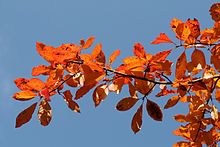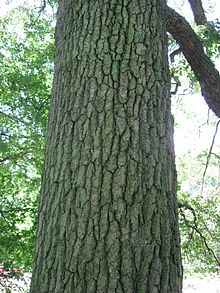My guess,
from Wikipedia:
Nyssa sylvatica's
genus name
(Nyssa) refers to a
Greek water nymph;
[1] the species
epithet sylvatica refers to its woodland habitat.
[1]
The species' common name
tupelo is of
Native American origin, coming from the
Creek words
ito ‘tree’ and
opilwa ‘swamp’; it was in use by the mid-18th century
[2]
While these trees are often known as simply "tupelo", the fuller name
black tupelo helps distinguish it from the other species of the
tupelo genus
(Nyssa), some of which have overlapping ranges, such as
water tupelo (N. aquatica) and
swamp tupelo (
N. biflora). The name "tupelo" is used primarily in the
American South; northward and in
Appalachia, the tree is more commonly called the
black gum or the
sour gum, although no part of the plant is particularly gummy.
[1] Both of these names contrast it with a different tree species with a broadly overlapping range, the
sweet gum (Liquidambar styraciflua), which does produce an aromatic resin.
[1] Another common name used occasionally is the
Northeast is
pepperidge.[1]
On
Martha's Vineyard, in
Massachusetts, this species is called "beetlebung",[
citation needed] perhaps for its use in making the mallet known as a beetle,[
citation needed] used for hammering
bungs (stoppers) into barrels.
Description [edit]

 Nyssa sylvatica
Nyssa sylvatica leaves in the autumn.


Trunk of a mature
Nyssa sylvatica tree
Nyssa sylvatica grows to 20–25 metres (66–82 ft) tall, rarely to 35 metres (115 ft), with a trunk diameter of 50–100 centimetres (20–39 in), rarely up to 170 centimetres (67 in). These trees typically have a straight trunk with the branches extending outward at right angles.
[1] The
bark is dark gray and flaky when young, but it becomes furrowed with age, resembling
alligator hide on very old stems. The twigs of this tree are reddish-brown, usually hidden by a greyish skin. The pith is chambered with greenish partitions.
The
leaves of this species are variable in size and shape. They can be oval, elliptical, or obovate, and 5–12 cm (2–5 in) long. They have lustrous upper surfaces, with entire, often wavy margins. The foliage turns purple in autumn, eventually becoming an intense bright scarlet.
The
flowers are very small, in greenish-white in clusters at the top of a long stalk. The
fruit is a black-blue, ovoid stone fruit, about 10 mm long with a thin, oily, bitter-to-sour tasting flesh. There are from one to three such fruit together on a long slender stalk.
Additional characteristics include:
- Bark: Light reddish brown, deeply furrowed and scaly. Branchlets at first pale green to orange, sometimes smooth, often downy, later dark brown.
- Wood: Pale yellow, sapwood white; heavy, strong, very tough, hard to split, not durable in contact with the soil. Used for turnery. Sp. gr., 0.6353; weight of cu. ft., 39.59.
- Winter buds: Dark red, obtuse, one-fourth of an inch long. Inner scales enlarge with the growing shoot, becoming red before they fall.
- Leaves: Alternate, often crowded at the end of the lateral branches, simple, linear, oblong to oval, two to five inches (127 mm) long, one-half to three inches (76 mm) broad, wedge-shaped or rounded at base, entire, with margin slightly thickened, acute or acuminate. They come out of the bud conduplicate, coated beneath with rusty tomentum, when full grown are thick, dark green, very shining above, pale and often hairy beneath. Feather-veined, midrib and primary veins prominent beneath. In autumn they turn bright scarlet, or yellow and scarlet. Petioles one-quarter to one-half an inch long, slender or stout, terete or margined, often red.
- Flowers: May, June, when leaves are half grown. Polygamodiœcious, yellowish green, borne on slender downy peduncles. Staminate in many-flowered heads; pistillate in two to several flowered clusters.
- Calyx: Cup-shaped, five-toothed.
- Corolla: Petals five, imbricate in bud, yellow green, ovate, thick, slightly spreading, inserted on the margin of the conspicuous disk.
- Stamens: Five to twelve. In staminate flowers exserted, in pistillate short, often wanting.
- Pistil: Ovary inferior, one to two-celled; style stout, exserted, reflexed above the middle. Entirely wanting in sterile flower. Ovules, one in each cell.
- Fruit: Fleshy drupe, one to three from each flower cluster. Ovoid, two-thirds of an inch long, dark blue, acid. Stone more or less ridged. October.[3]
Distribution [edit]
Nyssa sylvatica grows in various uplands and in alluvial stream bottoms from southwestern
Maine and
New York, to extreme southern
Ontario, central
Michigan,
Illinois, and central
Missouri, south to southern Florida, eastern
Texas, and eastern
Oklahoma. It also occurs locally in central and southern
Mexico.
[4] Optimum development is made on lower slopes and terraces in the
Southeastern United States






